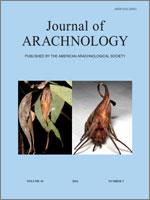We compared the effect of Ultraviolet A radiation on the adhesive droplets of the diurnal orb-web weaver Argiope trifasciata Forskaal, 1775 and the nocturnal orb-web weaver Neoscona crucifera (Lucas, 1838). We hypothesized that glycoprotein glue within A. trifasciata droplets will either be unaffected or will benefit from UVA exposure, whereas the glycoprotein of N. crucifera will be degraded by UVA. In both species, the volume of fresh droplets did not differ from that of droplets that were exposed to UVA for four hours, or from the volume of droplets kept in the dark for four hours. This documented that UVA did not affect compounds that confer droplet hygroscopicity. Both dark and UVA treatments reduced the relative toughness of droplet glycoprotein, though the reductions were not statistically significant, with the dark treatment exhibiting a greater decrease in relative toughness. This study suggests that ecologically relevant levels of UVA exposure do not affect the glycoprotein glue of orb-weaver capture silk.
How to translate text using browser tools
1 November 2016
The impact of UVA on the glycoprotein glue of orb-weaving spider capture thread from a diurnal and a nocturnal species (Araneae: Araneidae)
Sarah D. Stellwagen,
Brent D. Opell,
Mary E. Clouse
ACCESS THE FULL ARTICLE

The Journal of Arachnology
Vol. 44 • No. 3
November 2016
Vol. 44 • No. 3
November 2016
adhesion
Biomaterials
silk
toughness
ultraviolet




